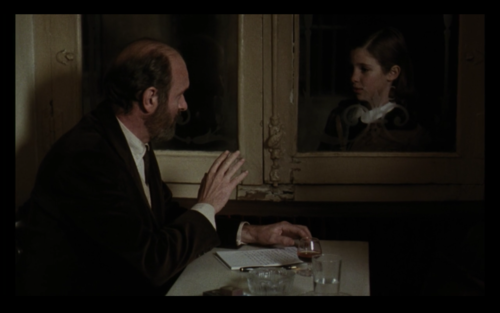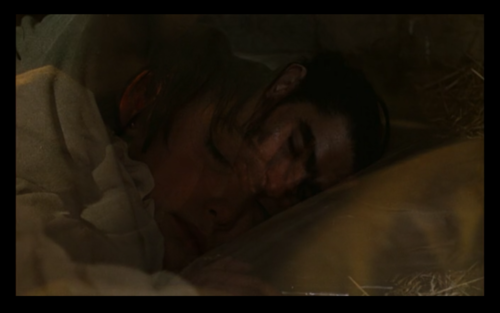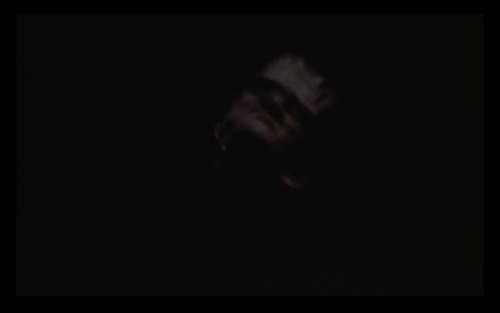What follows is a guest post by Byron Davies (Harvard). This column is on the 18th century Swiss Francophone philosopher Jean-Jacques Rousseau and the contemporary Spanish director Víctor Erice, especially the latter’s films The Spirit of the Beehive and El Sur.
It is tempting to think that cinema somehow has a prehistory in philosophy. That is, among those philosophers who pre-date the invention of cinema, there are some whose very spirits seem to inform the medium itself, making their connections to particular films, even if only implicit, seem especially fated or necessary. Strikingly, these are often philosophers somehow opposed to theater and “theatricality,” and known for harshly depicting the effects of sitting isolated in the dark. (The well-worn comparisons between cinema and Plato’s Myth of the Cave come to mind.)
Among such philosophers is surely Jean-Jacques Rousseau, an eighteenth-century philosopher who asked what it is to be spectator of, as well as a spectacle for, other persons. For Rousseau, among the characteristic features of our social lives is our caring to be noticed, which in turn involves our acknowledging others as capable of noticing us: as creatures that, unlike mere things, can subject us to their evaluative gaze. That is, for Rousseau, we cannot make spectacles of ourselves without acknowledging or, in a sense, also making spectacles of others.
At least, this is one way of understanding the role of “spectacles” in Rousseau’s various accounts of the origins of sociality in humans: either phylogenetic (as in the Discourse on the Origins of Inequality and the Essay on the Origin of Languages) or ontogenetic (as in his educational treatise and novel Emile). But “spectacles” come up even more directly and literally in his criticisms of the theater (especially in his Letter to d’Alembert on “spectacles”), and especially in his insistence that, if there is anything good in the acknowledgment of one another as spectacles, it is perverted in the institution of the theater, where spectacles are entirely bought and the expressions of persons (the actors) are sold.
On Rousseau’s understanding of the theater, the actor, under force of his dependence on the spectator for his livelihood, must “counterfeit” himself, or put his person “publicly on sale” [1]. That is, the actor must falsify himself, not just in the sense that he must play a character, but also in the sense that he must be false to the spectator: he flatters the latter’s capacity for identification or pity. For example, Rousseau refers to the Greek despot Alexander of Pherae:
who dared not attend the performance of a single tragedy for fear that he might be seen to moan with Andromache and Priam, but who listened without emotion to the cries of so many citizens daily being murdered on his orders. [2]
In a reversal of Aristotle’s views on the theater (according to which the catharsis of tragedy has beneficial effects), Rousseau thinks that among the theater’s pathological effects is its exhausting one’s capacities for being a sympathetic spectator:
[Has] he [the spectator] not acquitted himself of all that he owes to virtue by the homage which he has just rendered it [in watching a play]? What more could one want of him? That he practice it himself? He has no role to play; he is no actor. [3]
Thus, insofar as the theater is a locus of buying and selling, the spectator becomes an unsympathetic master and the actor an alienated laborer. (In Rousseau’s vision of popular sovereignty, and the entertainments permitted in an egalitarian republic, there will be no distinction between spectator and actor, any more than between between master and servant: “let the spectators become an entertainment to themselves; make them actors themselves; do it so that each sees and loves himself in the others so that all will be better united.” [4]).
It goes without saying that the theater and the cinema are not the same thing. But it is interesting that whereas for Rousseau the theater (at least outside republican entertainments) is a site for the failure of mutual acknowledgment, for the Spanish director Víctor Erice, the cinema is where some of the most important identifications take place.
Indeed, both of Erice’s two fiction features (The Spirit of the Beehive [El espíritu de la colmena], from 1973, and El Sur, from 1983) boast scenes in movie theaters, and both involve their protagonists’ finding their capacities for identification awakened in the cinema, or around the cinema. For example, in El Sur eight-year-old Estrella (Sonsoles Aranguren) follows her father (a disillusioned republican teacher persecuted under Franco) to the cinema, where he is watching a film featuring an actress whose name (‘Irene Rios’) Estrella has found written over and over again in his papers. Estrella later finds him in a cafe composing a letter to that same actress, or at least that is what she imagines: the voiceover narration of older Estrella gives way to the voice of her father’s letter, leaving it ambiguous whether we are hearing its real or its imagined contents. When her father notices Estrella observing him, the voiceover of her later self again takes over: “Now I understand that he reacted as if I’d caught him doing something wrong.” Estrella’s following her father to the movies serves as a kind of primal scene, a mysterious suggestion of something about her prehistory, one that at least allows her (even if only in recalling the moment years later) to give context to his emotional unavailability.

The cinema as site of identification: El Sur.

El Sur: “Now I understand that he reacted as if I’d caught him doing something wrong.”
Themes of identification in the cinema organize The Spirit of the Beehive even more explicitly. Set on the Castilian Plain in 1940, just after the defeat of republicanism in the Spanish Civil War, The Spirit of the Beehive opens with six-year-old Ana (Ana Torrent, in her very first role) joining her older sister in a rustic, makeshift cinema for a screening of James Whale’s 1931 Frankenstein. Throughout the twenty minutes or so in which scenes from Frankenstein appear, Erice particularly focuses on the monster’s encounter with a young girl, whom he kills by throwing into a pond (naively thinking she will float like the flower petals he had just seen her tossing in). Here Ana is invited to identify with at least two others, both, like her, still very innocent in the ways of the world: a child and a monster (or a child-like monster).


The Spirit of the Beehive: Ana identifies with both the child and the monster.
Thinking through the importance of Ana’s identifying with a monster, as I’d like to do, will require understanding how Rousseau’s writing on spectatorship and The Spirit of the Beehive do seem to speak with one another, and even more deeply than by way of contrast. And among the film’s particular connections to Rousseau is a shared association between feeling a spectacle and feeling confronted by a Giant. (I should note that at least part of this connection is by way of Mary Shelley: the literary scholar David Marshall has argued convincingly that Rousseau’s writing was a profound influence on the author of Frankenstein, informing the notions of savagery, exile, and indeed spectatorship rife in that novel. [5]) For example, in a passage in the Essay on the Origin of Languages, Rousseau imagines the early human’s (the sauvage’s) first confrontation with others of his kind:
A [sauvage] meeting others will at first have been frightened. His fright will have made him see these men as larger and stronger than himself; he will have called them Giants. After much experience he will have recognized that since these supposed Giants are neither bigger nor stronger than he, their stature did not fit the idea he had initially attached to the word Giant. He will therefore invent another name common to them and to himself, for example the name man,and he will restrict the name Giant to the false object that had struck him during his illusion. [6]
The sauvage is frightened by others of his kind not just because they threaten his physical integrity, or serve as competitive threats, but also because they render him a spectacle, the object of their gaze. Rousseau is describing the birth of sociality, and thesauvage sees others as Giants because they are significant to him: he cares about how he is taken in by them. (When he identifies with them, and comes to see them as fellow creatures, it is because he comes to see them as thinking the same of him. [7])
Similarly, The Spirit of the Beehive is throughout informed by a child’s confrontation by a Giant. Ana’s fascination with Frankenstein’s Monster, the way the movie stays with her (as movies do), typifies her relationship with anything else large, adult, and masculine: a republican fugitive she discovers in hiding, her own (like Estrella’s) emotionally unavailable father. It also typifies her relationship with anything else that can look back at her, or confront her with an independent point of view. This is most obvious when, in a schoolroom exercise, she must guess what is missing from a mannequin called “Don José.” Only when provoked by her older sister can she see that Don José is missing his eyes. And only when restoring his eyes to him does she feel the significance of being looked upon: that, unlike the lungs or the stomach (which Don José had also had missing), the eyes evaluate, they judge, they take a point of view. As Dr. Frankenstein knew, building a Giant can be scary, because it can look back at you. (Later in the film we see a portrait of Franco hanging on the same schoolroom’s wall.)

“Now Don José can see.”
The men in Ana’s life (her father, the republican fugitive) are Giants because they could not remain mere spectacles (just as, in her later hallucinatory visions of Frankenstein’s monster, the latter could not just stay up on the screen): they also make a spectacle of Ana. In fact, it seems less apt to characterize Ana’s response to these Giants as horror than as fascination or identification: she can feel their fear, including their fear of her, as when she startles the republican fugitive in his hideout. She goes to sleep, and her image fades into his, underscoring her identification with him. Having once seen him as a Giant (he’s hiding in the hut where her sister told her she could find Frankenstein’s monster), she now sees him as a fellow creature. (What she doesn’t know is that the Francoists will soon exterminate him like a rat.)

Ana blends into the republican.
These identifications reach an apex when (startled by her father’s learning of her encounter with the fugitive) she runs away from home, and, finding a pool of water, her reflection in it becomes the very image of Frankenstein’s monster. Like Rousseau’ssauvage, she no longer feels small before a Giant, but understands him to be just as significant, or insignificant, as she is. In watching her image transform into his, she indeed transforms into a Giant; but she also, by virtue of that, renders the Giant a child. That is again the poignancy of the Monster’s encounter with the young girl (in the 1931 film, the scene that Ana is, in these hallucinations, replaying): again, the monster and the child are both innocents, both are receiving their early education in things; if one is more dangerous, that’s only because he’s fated to be bigger. (Since Ana’s older sister typically bullies and provokes her, her fantasy of meeting the monster might also be her fantasy of equality, of having a true peer.)


Ana blends into the monster.
Of course, so long as Ana can only see herself through the Giants that surround her, she also lacks much a sense of who she is. (Rousseau, who later in life was accused of being a monster, begins his last work, The Reveries of the Solitary Walker, asking, in desperate retort to these accusations, “What am I?” [8]) But that just underscores the importance of Ana’s return home from her exile (from her own solitary walks), and how that return constitutes an achievement of sovereignty: after waking up from a deep sleep (she’s had a “very powerful experience,” a doctor says, ambiguously) she declares out of her window (and to the world) “I am Ana” (“Soy Ana”). Until then those words had been the province of others: her older sister had instructed her to use them to invoke Frankenstein’s monster (Beetlejuice-like or Candyman-like, but using Ana’s own name, and thus emphasizing her identification with him). Only now can she hear herself in those words.
Thus, a film made in the waning years of the Franco regime ends with a child’s declaration of sovereignty after a period of exile. Having only seen herself through others, or through her identification with Giants, she finally becomes a spectacle for herself. Or rather: in contrast with Rousseau’s spectator, Ana does have a “role to play.” For Ana, finally coming to say ‘I’ means, as with the participants in republican “spectacles,” being actor and spectator at once.

“Soy Ana”: Ana declares her sovereignty.
- Rousseau, the Letter to d’Alembert p. 79, published asPolitics and the Arts, trans. Allan Bloom (Ithaca, NY: Cornell University Press).
- Rousseau, Discourse on the Origins of Inequality pp. 152-53, trans. Victor Gourevitch, in The Discourses and Other Early Political Writings, Cambridge: Cambridge University Press, 1997).
- Rousseau, the Letter to d’Alembert p. 25
- Ibid. p. 126
- David Marshall, “Frankenstein, or Rousseau’s Monster: Sympathy and Speculative Eyes,” in his The Surprising Effects of Sympathy: Marivaux, Diderot, Rousseau, and Mary Shelley (The University of Chicago Press, 1988). Marshall is especially helpful in his developing the idea of Mary Shelley’s reading of Rousseau as a kind of primal scene: as her attempt to understand her pre-history through understanding her Rousseau-influenced parents, Mary Wollstonecraft (who died after giving birth to her daughter) and William Godwin.
- Rousseau, Essay on the Origin of Languages p. 254, trans. Victor Gourevitch, in The Discourses and Other Early Political Writings, Cambridge: Cambridge University Press, 1997).
- In his reading of this passage, Stanley Cavell writes, “A natural reading of Rousseau’s scene is to take the savage man to be frightened by one who is frightened upon meetinghim. (It is of the essence of this passage of initial human confrontation to see that everything said about either the one or the other is true of both.)” From Cavell, The Claim of Reason: Wittgenstein, Skepticism, Morality, and Tragedy p. 467 (Oxford: Oxford University Press, 1979).
- Rousseau, The Reveries of the Solitary Walker p. 1, trans. Charles E. Butterworth (Indianapolis: Hackett Publishing, 1992).

